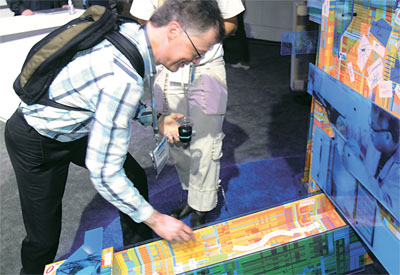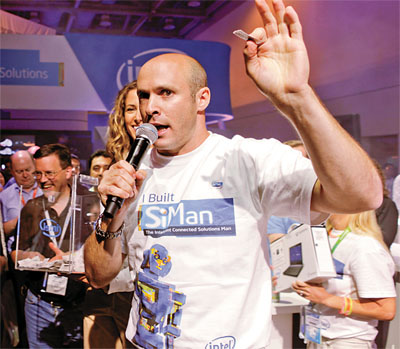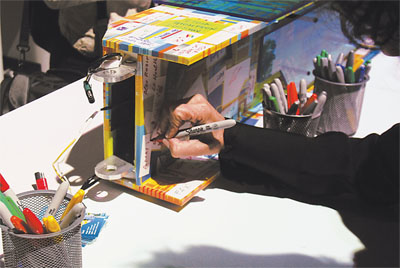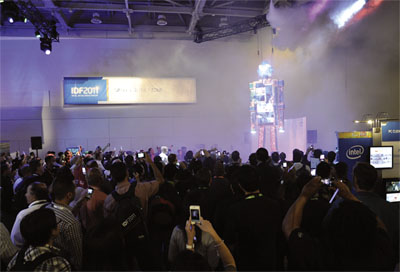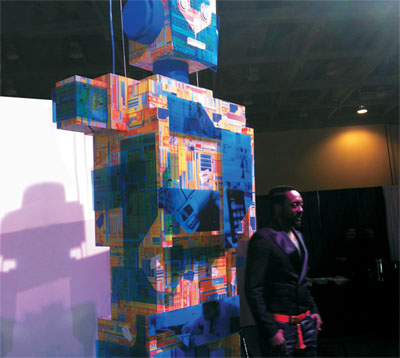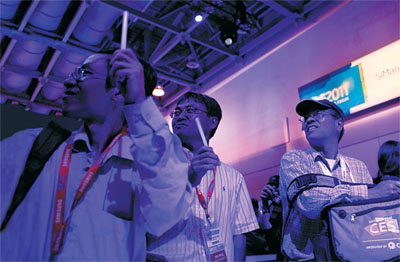| TRAFFIC BUILDER |
Exhibitor: Intel Corp.'s
Intelligent Systems Group
Creative/Production: Live Marketing Inc.,
Chicago, 312-787-4800,
www.livemarketing.com
Production: Taylor Inc.,
Brampton, ON, Canada,
800-605-6519,
www.taylorinc.com
Show: Intel Developer Forum, 2011
Budget: $50,000
Goals:
 Attract 500 attendees to the booth and lure 380 attendees back for the reveal event. Attract 500 attendees to the booth and lure 380 attendees back for the reveal event.
 Generate thousands of
impressions via social media. Generate thousands of
impressions via social media.
Results:
 Drew more than 700
attendees to the ISG booth and attracted 400 guests to the reveal event on day two. Drew more than 700
attendees to the ISG booth and attracted 400 guests to the reveal event on day two.
  Scored 43,000 Twitter
impressions, 9,000 Facebook impressions,
and 1,000
YouTube
video views. Scored 43,000 Twitter
impressions, 9,000 Facebook impressions,
and 1,000
YouTube
video views. |
 he merger of Burning Man and corporate America is about as likely as Lady Gaga and Warren Buffet hooking up. For while corporate America is driven by a relentless pursuit of the almighty dollar, Burning Man is based on the idea of creating a radical, spontaneous community absolutely void of commercialism. he merger of Burning Man and corporate America is about as likely as Lady Gaga and Warren Buffet hooking up. For while corporate America is driven by a relentless pursuit of the almighty dollar, Burning Man is based on the idea of creating a radical, spontaneous community absolutely void of commercialism.
Drawing upwards of 45,000 people to Nevada's Black Rock Desert, the art-festival-slash-self-expression event culminates in the burning of a human effigy that towers 80 feet above the masses. The weeklong affair challenges visitors (aka burners) to contribute to the pop-up populous,
be it by building the human form, sharing their creativity,
and/or ensuring that the experience leaves nary a trace upon the desert after its completion. What's more, Burning Man is based on
10 guiding principles, including complete inclusion (as there are no prerequisites for "community" membership), participation (attendees must be participants, not spectators),
and "decommodification" (commercial sponsorships, transactions, and advertising are strictly prohibited). So as you can see, in the eyes of dollar-driven corporate America, Burning Man is pretty much the antichrist.
Nevertheless, Intel Corp.'s Intelligent Systems Group (ISG) made a deal with the devil at the Intel Developer Forum (IDF). Held Sept. 13 - 15, 2011, at San Francisco's Moscone Center, IDF is an annual trade show and educational conference that hosts roughly 5,000 developers and programmers, i.e., the people that dream up the whiz-bang software,
hardware, and applications that run on Intel architecture. Here, the ISG hoped its booth would fulfill traditional
corporate goals, such as generating awareness and fostering Intel's position as a technology and thought leader. But
according to Len Klebba, who oversees event marketing for the ISG, it also wanted to nurture creativity and cultivate a sense of community between the ISG and attendees. And given these atypical aspirations, Burning Man and the ISG were a match made in exhibit-marketing heaven.
Before the Betrothal
To further comprehend why the ISG's mismatched
marriage made sense, it's important to understand a little bit more about the ISG and IDF. Simply put, the ISG sells
microprocessor technology that's embedded within devices or components to enable smart connectivity. For example, the ISG recently inked a deal to provide Nissan Motor Co. with the processors that run many of its "in-vehicle infotainment" systems. Another example involves special digital-signage systems featuring Intel Core processors. Using Anonymous Video Analytics (AVA) software, the processors display multimedia messages while at the same time measuring marketing effectiveness.
Thus, original equipment manufacturers (OEMs) purchase the ISG's processors and embed them in their products so they can communicate with other machines and with the cloud, and so they can interact intelligently over a network. The processors provide the brains and the power that run various programs. In order to sell its processors, then, the ISG needs software and applications (like the AVA) that are designed to run on Intel processors
and that are somehow attractive to OEMs. And since consumers - and thus OEMs - are constantly searching for the latest gotta-have-it technology, the ISG needs a constant stream of innovative new products and software coming down the pipe.
So to ensure the stream doesn't run dry - and that developers write programs for the ISG's processors as opposed to those of competitors - Intel hosts the IDF. The event, which attracts developers, programmers, and approximately 600 industry journalists, draws roughly 150 exhibitors, including
multiple divisions within Intel along with various outside firms. For Intel in general and the ISG in particular, IDF serves two main functions. First, it allows Intel to demonstrate its technology leadership - to prove to attendees that Intel's technology is better than that of competitors, and is worthy of their development efforts. And second, it serves as a platform to motivate developers and programmers to come up with new, creative, and sellable ways to use Intel's technology, thereby supporting that steady stream.
Granted, the majority of the show floor is filled with exhibits from Intel's various divisions, and in 2011 the ISG group had a 40-by-50-foot booth among them. "But all 150 exhibitors are trying to attract the same 5,000-plus attendees,
as most of them want developers to craft applications specifically for their unique markets," says Anne Trompeter, executive vice president and senior creative director at Live Marketing Inc., the Chicago marketing agency the ISG hired to devise a killer traffic-building concept.
What's more, the ISG's relationship with developers also poses a significant challenge in terms of tracking trade show success. Generally speaking, since the ISG doesn't sell a product to developers, and awareness and thought leadership top the company's exhibiting goals, there's no need for the ISG to gather and track leads. Nevertheless, it needs hard-core numbers to measure its success and prove its worth to the Intel brass in the corner offices.
So when the ISG enlisted the help of Live Marketing
for its IDF 2011 exhibit, it had four requirements: 1) Demo Intel products to maintain the company's position as a thought and technology leader, 2) create a sense of
community among attendees and between attendees and the ISG (as community builds loyalty), 3) generate massive awareness on the show floor and in the developer community, and 4) separate the ISG from the masses by creating a radical concept to drive traffic and generate show-wide buzz. "The ISG came to us and said, 'Give us your craziest
out-of-the-box ideas that will make us the talk of the show,'" Trompeter says. "We tossed out a few concepts, but before long, Burning Man trotted to the forefront."
The First Date
So how does a seemingly impossible union between Burning Man and corporate America avoid a Romeo and Juliet-style demise? "If you think about it, Burning Man is actually a perfect analogy for the ISG," says Kristin Veach, Live Marketing's senior vice president of marketing and business development. "Our idea was to allow attendees to embellish and assemble a Burning Man-style human form during the show and to pair this activity with product demos, giveaways, and a show-stopping reveal."
The Burning Man concept, then, would expose attendees to Intel products, and foster creativity and a sense of community as people added their artistry to the project. And like the real Burning Man festival, the show-floor activity would culminate in a buzz-worthy event - but instead of burning the effigy, the ISG would reveal what had by then become an 18-foot-tall behemoth to the crowd. The theatrical reveal would hoist the humanoid form to a "standing" position to tower over the show floor like a pissed off Optimus Prime.
Needless to say, the ISG fell in love with the Burning Man idea, so Live Marketing forged ahead. Its first chore: Renaming the Burning Man concept. After all, this wasn't a Burning Man event; it was an ISG event. After running into myriad copyright and corporate-communications issues, the Live Marketing and ISG team named their human effigy SiMan. The team admits the name is a little twisted, as it was concocted by reversing the "I" and "S" from ISG and giving a nod to the same letters in the ISG tagline for the show - Intelligent Connected Solutions. But despite its somewhat warped state, SiMan has a better ring than IsMan.
Next up was finding a company to craft SiMan's
components, including a core, a head, and various limbs, to which attendees would attach artistic embellishments. In addition, attendees would also help connect these elements (to play up the Intelligent Connected Solutions tagline) and essentially construct SiMan on site at IDF. For that, the team turned to Taylor Inc., an exhibit house based in Brampton, ON, Canada. "We started with the basic concept of a Burning Man-like structure, but with a high-tech twist," says David Hunter, account director at Taylor. "Ultimately, we created multiple components comprising a metal frame sheathed in wood and skinned with a vinyl, multicolored computer-chip-like motif. Strings of LED lights ran throughout the elements, and tiny LED fixtures were used to create SiMan's facial features."
With SiMan under construction, Live Marketing crafted various complementary activities and messaging. The resulting SiMan-based program - which comprised
everything from the SiMan activity to partner promotions to a Will.i.am booth visit - not only exceeded the ISG's goals; it also impressed our judges. "This idea wasn't just cutting edge," one judge said. "It was a unique traffic builder/integrated program hybrid that certainly must have sparked developers' imaginations."
Pre-Show Pyrotechnics
The ISG's program launched nine days before IDF with clever yet curious posts via Intel's Facebook page and Twitter account. "To develop a sense of intrigue that would drive attendees to the booth," Trompeter says, "we took pictures of various SiMan components, such as a limb, a foreleg, a head, etc., and then tweeted the photos or posted them on Facebook along with promotional text such as, 'Come connect with us and help create SiMan, a symbol of Intel's intelligent solutions.' This way images illustrated how cool he was going to be, but there was a huge curiosity factor about what he would look like."
When attendees entered the Moscone Center on Sept. 13, they
immediately discovered SiMan-related banners suspended in the foyer. While perusing the hall, they also learned of the SiMan experience via four other exhibitors, Intel's strategic partners that had agreed to promote the SiMan activity. "To create show-wide visibility for SiMan, we contacted several other divisions within Intel as well as some independent companies prior to the show," Trompeter says. "We explained the SiMan campaign and asked if they'd like to be a part of it." Not surprisingly, four exhibitors agreed to participate, eagerly hoping to associate themselves with what surely would be an unforgettable experience.
Thus, the ISG placed 8.5-by-11-inch signs in each partner's booth. Along with a rendered image of SiMan's upper torso, sans attendee embellishments of course,
the signs featured the text "We're Supporting SiMan's
Assembly." Text urged attendees to obtain a glow stick and a SiArt Piece from the partner exhibitors and to take them to the SiMan Assembly Zone and "Be a part of it!" Once again, attendee curiosity was piqued as they wondered how a glow stick and these SiArt Pieces - the roughly 1-by-0.5-inch dye-cut vinyl embellishments attendees would later decorate and attach to SiMan - might be put to use.
SiMan Comes to Life
Whether the promotions lured attendees to the booth or they just happened to stumble upon it, people were drawn to the SiMan Assembly Zone, a 20-by-40-foot area that was bathed in bright-white lights and featured a techno soundtrack playing in the background. The area comprised four 12-foot-long white tables, each of which offered its own supply of colorful Sharpie pens attendees could use to decorate their SiArt Pieces. The white tables also supported SiMan's components, which were each
attached at a scheduled time throughout the show.
As attendees approached the zone, members of the
SiCrew, i.e., professional engagers hired to facilitate the activity, explained the process and encouraged attendees
to take their place at any of the tables. They then handed out SiArt Pieces to attendees who hadn't already picked them up at partner booths, and encouraged visitors to use the provided markers to draw, sketch, and doodle on the vinyl. Finally, they illustrated how the sticker-like backing peeled away to reveal adhesive, and instructed attendees to "Make your mark on SiMan" by attaching their finished artwork to one of the SiMan components displayed in the Assembly Zone. After attendees completed and applied their artwork, SiCrew members attached stickers with the words "I Built SiMan" to attendees' shirts, and if attendees had yet to visit the demo area, staffers pointed them toward the main part of the booth, where product demos awaited them.
Demo-area and Assembly Zone staffers also handed each attendee an activity card, which gathered demographic information and explained the demo activity.
Like a traditional exhibit passport system, the activity card challenged attendees to participate in five of the 10 Intelligent Connected Solutions product demos and get their card stamped at each one. Those who returned a completed, stamped card to the Activity Zone - where they were placed inside a clear-Plexiglas box - were eligible for various small-prize drawings held throughout the show as well as two grand-prize drawings for netbooks taking place during the SiMan reveal. The small-prize drawings were conducted by a microphone-wielding presenter who selected one or two cards from the box every 30 minutes. If the winners were present in the booth, the presenter offered them Intel-branded swag, including everything from mugs and backpacks to T-shirts and pens.
With This Glow Stick, I Thee Wed
Maintaining traffic flow was a breeze on day one and two of the show. The first day of the show, attendees rushed to the booth to find out what this whole SiMan thing was all about. At this point, the back of the Assembly Zone featured the torso and head of SiMan in a "seated" position, where he was supported by sturdy metal chains attached to the overhead rigging. Near the end of day one, attendees gathered to help attach SiMan's right arm.
On day two, SiMan's remaining components were
attached at regular intervals. For example, the left arm went on at 11:30 a.m., and at 12:30 p.m., the right leg was attached, and staffers and attendees hoisted SiMan a few feet out of his original position. Throughout the day, staffers invited attendees back to the exhibit to witness each attachment, connect a SiArt Piece to SiMan, and hoist him higher.
Day two culminated in a theatrical production the likes of which IDF had never seen: Glow Time. Modeled after Burning Man's flaming finale when the human effigy goes down in a fiery blaze of glory, Glow Time was SiMan's moment in the sun - although to keep the fire marshals happy, the flames were replaced by glow sticks, and SiMan wasn't reduced to a pile of ashes.
Throughout the first two days of the show, staffers and partner exhibits promoted Glow Time. In addition to handing out glow sticks, they encouraged everyone to come back to the ISG booth at the end of day two for the big reveal and grand-prize drawings. By roughly 6 p.m., more than 400 glow-stick-wielding attendees - 100 more than the ISG's goal - swarmed the now-darkened space (achieved by turning off several overhead light fixtures in the venue). Dramatic music played in the background while the Assembly Zone's presenter acted as the Glow Time emcee, reinforcing ISG's "connected," "embedded," "community" verbiage.
With a theatrical flourish, featuring special-effects fog and spotlights, the 700-pound SiMan was raised to his full height of 18 feet and lit via his internal LEDs. Awestruck by the towering creature they'd helped create, attendees pulled out their cell phones to capture the moment and share their pictures and videos with family and friends. After a few words from the emcee and a round of applause for SiMan, the fog dispersed and the lights came up. But before attendees left, the presenter plucked two cards from the Plexiglas bin for the grand-prize netbook drawings.
When attendees returned on day three, they discovered
that SiMan was still fully suspended in the Assembly Zone, sans spotlights and fog. During the day, staffers and partners encouraged attendees to decorate SiArt Pieces, but instead of attaching them to a component in the zone, attendees could attach them directly to any part of SiMan (or rather those areas they could reach without a ladder). All told, the ISG estimates that more than 700 people participated in the Assembly Zone activity, adding more than 1,000 SiArt Pieces to SiMan - a number that surpassed the ISG's goal by more than 45 percent.
Ancillary Embers
The success of the SiMan activity, however, was augmented by several related activities - all of which further fostered the ISG's on- and off-floor visibility. For example, the ISG enlisted the help of its Facebook and Twitter presence to maintain the buzz about SiMan happenings. "As each component was about to go on SiMan, posts and tweets went out announcing the upcoming 'attachment,'" Trompeter says. "And of course, ongoing videos were posted to YouTube, culminating with the Glow Time experience."
Plus, Will.i.am - a paid spokesperson for Intel - made a show-floor appearance and spent time in the ISG booth. "We gave him a special Plexiglas piece to sign, which was later attached to SiMan," Trompeter says. "He also posed with SiMan, giving attendees an awesome photo op, and Intel's video crew documented the visit and posted videos and photos to YouTube, Facebook, and Twitter."
Since the ISG had never executed a program quite like this before, it didn't set concrete social-media goals, and instead hoped for thousands of impressions. In reality, the program's social-media efforts garnered more than 43,000 impressions on Twitter and approximately 9,000 impressions on Facebook. Additionally, its YouTube videos scored more than 1,000 views.
"From Will.i.am to Glow Time to the Assembly Zone activity, the ISG's Burning-Man-based program was a
tremendous success," Klebba says. "SiMan truly got attendees
involved in his creation, fostered developers' creativity, and generated amazing awareness." So it just goes to show, despite the naysayers and the cultural (or corporate) taboos, even an unlikely marriage of polar opposites can sometimes turn into a long-term love affair. E
|





 he merger of Burning Man and corporate America is about as likely as Lady Gaga and Warren Buffet hooking up. For while corporate America is driven by a relentless pursuit of the almighty dollar, Burning Man is based on the idea of creating a radical, spontaneous community absolutely void of commercialism.
he merger of Burning Man and corporate America is about as likely as Lady Gaga and Warren Buffet hooking up. For while corporate America is driven by a relentless pursuit of the almighty dollar, Burning Man is based on the idea of creating a radical, spontaneous community absolutely void of commercialism. 